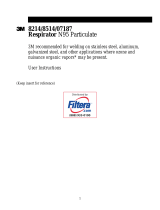
N95 respirators are eective at helping reduce the wearer's exposure to airborne particles
such as dusts and mists, but only if they’re worn correctly. Follow these tips to put on, take
o and wear your 3M respirator.
Tips for Wearing a
3M N95 Disposable
Cup-Shape Respirator
© 3M 2020. All rights reserved. December 2020
Respirator On First
Respirators should be put on rst before putting on a hat,
eyewear or earmus. The straps should be directly against
your head.
Pay Attention to Strap Placement
The position of the straps is critical to help create a proper
seal of the respirator to your face. A typical N95 respirator
design will instruct the top strap should be placed above your
ears high on the back of the head, and the bottom strap
should sit below your ears around your neck. Straps should
never be crisscrossed, twisted or looped around your ears.
Wearing the head straps as stated in the model specic user
instructions is necessary for a secure t.
Do Not Pinch the Nosepiece
Pinching the nosepiece with one hand can result in a poor t
on the bridge of the nose, potentially allowing contaminated
air to leak in through the gap when you breathe in, and could
cause fogging of eyewear when you breathe out. Instead, use
your ngers from both hands to completely mold the
nosepiece to your face.
Try Dierent Respirators
There are many dierent types of disposable respirators that
have a variety of features, such as more comfort, easier
breathability, adjustable straps, exhalation valves for easier
breathing, and dierent sizes. If you do not nd one very
comfortable or you do not get a good seal with one, try
another model.
Beware of Facial Hair
Facial hair such as a beard can compromise the seal between
your 3M N95 respirator and your face, which may reduce its
eectiveness. Even stubble can have an eect on the
respirator seal. You must be clean shaven when using
respirators. However, facial hair entirely within the respirator
cup (e.g., a small goatee or mustache that doesn’t interfere
with the respirator seal) is OK.
Secure Long Hair
Long, dangling hair can also pose problems with strap t
at the back of the head or with the seal to the face. Hair
should be secured in a ponytail or bun between the upper
and lower straps.
Remember the 3 Ds
If your respirator becomes dirty, damaged or dicult to
breathe through, it should be discarded and replaced. Any
N95 respirator that has come into contact with virus particles
should be carefully removed and appropriately handled
after use.
Be Mindful of Shelf Life
Do not use your respirator past its shelf life, typically 3 to 5
years from date of manufacture. The expiration date can be
found on packaging. Respirators should be stored according to
the storage instructions, including at temperatures no colder
than -4 degrees F (-20 degrees C), no hotter than 86 degrees
F (30 degrees C), and a relative humidity of less than 80%.
Things to Keep in Mind
N95
!

© 3M 2020. All rights reserved. December 2020
*If you have questions, call the 3M technical service line in the
U.S. call 1-800-243-4630 and in Canada call 1-800-267-4414.
Always read and follow product-specic user instructions.
DIY/Home Use: Use ONLY in NON-HARMFUL environments.
Occupational/Hazardous Use: Use under a regulated government (e.g. OSHA) respiratory protection program.
WARNING: Limitations apply. Misuse may result in sickness or death. See product packaging and insert,
or call 3M in USA at 1-800-243-4630. In Canada, call 1-800-267-4414.
N95
!
N95
!
N95
!
N95
!
Tips to Put It On Properly
Place on Face
To start, cup the respirator in your hand with the nosepiece at your ngertips, allowing
the headband straps to hang freely below your hand. Put the respirator up to your face
with the nosepiece over the bridge of your nose.
Position Straps
While holding the respirator in place, pull the top strap over your head so it rests high
on the back of your head and above your ears. Next, pull the bottom strap over your
head and place it around your neck just below your ears. Untwist the straps.
Form the Nosepiece Correctly
To get a good seal around the nose, you need to mold the nosepiece carefully to help
prevent air leakage. To do this, use two ngers from each hand to mold the nosepiece
to the shape of your nose. Push inwards and down while moving your ngers down
both sides of the nosepiece.
Check the Seal
To perform a User Seal Check, cover the respirator with both hands and, for
non-valved respirators, exhale sharply; for valved respirators, inhale sharply. Be careful
not to disturb the position of the respirator. No air leaks should be felt between the
face and the respirator edges. If air does leak, readjust the nosepiece, work the straps
back along the sides of your head and repeat the seal check. If you cannot achieve a
proper t without air leaks, try another respirator model.
Take It O Properly
How to Take Respirator O
To remove, cup the respirator in one hand to hold it on your face. With your other
hand, pull bottom strap overhead, then pull top strap overhead and remove respirator.
An alternative way to remove the respirator without touching it is to rst pull the
bottom strap over your head and then pull the top strap over your head.
N95
!
N95
!
-
 1
1
-
 2
2
Ask a question and I''ll find the answer in the document
Finding information in a document is now easier with AI
Related papers
-
3M Disposable Respirators DL DPR Operating instructions
-
3M 8210PH6-DC Operating instructions
-
ERB Safety 7185 User manual
-
3M 38210Plus/8210/07048/8110S User manual
-
3M N95 User manual
-
3M 8210 User manual
-
3M N95 Owner's manual
-
3M 8515/07189 User manual
-
3M 7187 User manual
-
3M Disposable Respirators DL DPR Operating instructions




